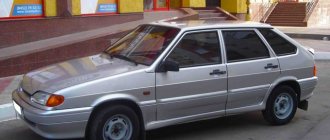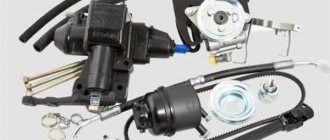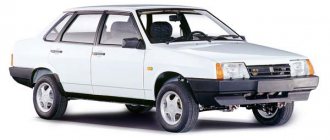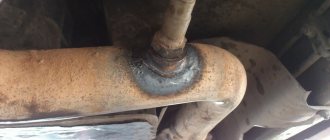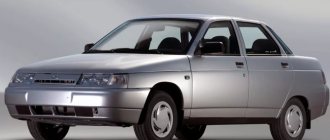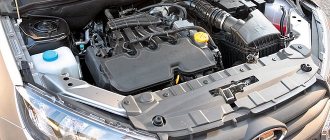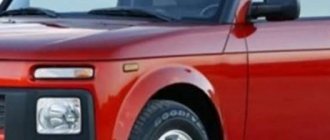Brief description of the Niva design and its modifications
Niva 2121 transmission: diagram, description, video
The Niva model range and modifications differ in transmission, engine size, fuel supply system, body structure and overall dimensions, electrical equipment:
VAZ-2121 is the first basic model of the Niva with a 1.6-liter engine, produced from 1976 to 1994.
VAZ-21211 is a modification produced from 1978 to the early 1980s. This model was equipped with a VAZ-21011 engine, the volume of which was 1.3 liters. The delivery was made for export to some European countries. The interest of Europeans in equipping such a car was based on savings in paying taxes.
VAZ-21212 is the base model of the Niva VAZ-2121, but the design has been changed for right-hand drive. Delivery was carried out to countries with left-hand traffic (Great Britain, India, Japan, Australia, etc.).
Niva 21212 Lada
VAZ-21213 – created on the basis of the VAZ-2121 model. The engine features a 0.1-liter (1.7-liter) displacement and increased camshaft lobe height. The car has a reinforced clutch, compared to the VAZ-2121. The steering wheel was replaced and a more organic instrument panel was installed.
VAZ-21214 is a modified version of the VAZ-21213, in which the carburetor system was replaced by General Motors central fuel injection.
The injection control system was powered by an MP7.0 Bosch controller and was little known in Russia due to its installation on passenger cars exported to near and far abroad. The exception was the Niva car from the moment the injection system was implemented on its engine.
No major changes were made to the design of the VAZ-2121 for a long time, but painstaking work was and is still ongoing to improve the control system. This is also due to environmental requirements and the desire of the manufacturer to raise the technical level of the car in such important parameters for owners as the dynamism of the car and reduced fuel consumption.
Currently, most Niva cars work with a control system that uses Bosch M7.9.7 or ME17.9.7 controllers.
Lada Niva 21214
VAZ-21217 is a modified version of the VAZ-21213 with a 1.6-liter engine. The peculiarity of the version is the use of a driven clutch disc from a VAZ-2121, which is interchangeable with a VAZ-2106 Zhiguli disc.
VAZ-21218 is a modification with an extended wheelbase, which is 300 millimeters larger than the short-wheelbase model (2200 mm). The model is distinguished by doors whose width has reached 1200 mm and is most convenient for seating passengers in the rear seat.
VAZ-2129 (popular name “Niva-Kedr”) is a three-door car and the length is 500 mm longer than the base model, but unlike the VAZ-21218, the door width has not changed. The rear seat is moved towards the trunk and creates comfortable conditions for the passengers' legs. A small series of cars of this type are made with an additional fuel tank installed - model VAZ-2129-01.
Lada Niva 2129
The VAZ-2130 is a relative of the VAZ-2129 and the main difference is the increase in trunk volume by installing the rear seat forward by 30 centimeters.
VAZ-2131 is similar in size to models 2129 and 2130, but more comfortable for passengers, as it already has five doors. The rigidity of the body on this car is inferior to that of the three-door, but owners who operate the car on smooth road surfaces are of little concern about this fact. VAZ-21312, -21312-01 are additional modifications equipped with a 1.8-liter engine, while modification 21312-01 has an additional fuel tank.
Special vehicles are produced on the basis of Niva:
— for transportation of small weight and dimensions of cargo;
— armored for financial organizations;
- for the services of the Ministry of Internal Affairs, Ministry of Emergency Situations, medicine, etc.
The first cars (carburetor) were equipped with a mechanical four-speed gearbox (starting from 21213 - five-speed), a two-speed transfer case and a locking center differential. The geometric parameters of cross-country ability are improved due to a fairly high ground clearance (220 mm), small body overhangs (approach angle 32°, departure angle 37°) and a relatively short 2.2-meter wheelbase. The first VAZ-2121 model was equipped with a VAZ-2121 engine, created on the basis of the VAZ-2106 engine. On the 2121 engine, the maximum power is 80 hp. s., and the restyled modification of the VAZ-21213 is equipped with a VAZ-21213 engine with an increased volume of up to 1690 cm³ and a power of 81.9 liters. With.
What can you say about Taiga's appetites?
A type of SUV under the tempting name “Taiga” is especially preferred among fishermen and hunters. Of course, fuel consumption will largely be related to driving style, time of year, and engine modification. The five-door version will require up to 13 liters in city mode, up to 11 in mixed mode and 9.5 liters on the highways.
In cases where the carburetor settings are correct, the reason for the increase in fuel consumption may be increased wear of the piston group parts.
Then you can see what the gasoline consumption will be on various modifications of the Lada 4x4, better known under the Niva brand, according to the manufacturer.
VAZ-21213 (1.7 carburetor 76 hp)VAZ-21214 (1.7 80 hp injector)VAZ-2131 (1.8 82 hp carburetor)VAZ-2131 (1.7 80 hp injector) Gasoline consumption liters per 100 km (l/100 km) Urban cycle 13,411,511,212,312,2 Country cycle 10,88,38,29,49,2 Combined cycle 13,111,210,212,111,9Malfunctions
| FAULTS | CAUSES AND REPAIRS |
| The appearance of a characteristic knock at the bottom of the engine. | This indicates problems with the main bearings. The car must be towed by a tow truck to a service center and the appropriate repairs must be carried out. |
| The appearance of a pronounced knocking sound with a metallic sound. | The reason for this is problems with the bearing rods and piston pins. It should be said that operating a car with such problems may subsequently lead to the need for expensive major repairs. |
| Engine troubles at low speeds. | There may be several reasons for engine tripping: first of all, it is the use of low-quality gasoline. It is also possible that carbon deposits may appear in the combustion chamber. In rare cases, problems are observed in the operation of the injection system. Repair in this case is carried out only after a comprehensive diagnosis. |
| Loud knocking sound when the engine is not warmed up. | This may indicate the beginning of camshaft wear. This problem is typical for power units whose mileage exceeds 100,000 kilometers. It is necessary to carry out appropriate diagnostics and then replace the camshaft. |
Niva tuning: 145 photo ideas on how to improve the VAZ 2121 with your own hands
Also interesting: Niva and Chevrolet Niva Tuning Shop from 10:00 to 18:00
Technical characteristics of the carburetor version
Since what year did the injector on the Niva make the previous model become a thing of the past? pros and cons of such a machine compared to the carburetor version
To find out which Niva is better - carburetor or injection, first you need to consider the technical characteristics of both models. So, let's start in order. Initially, the engine for the Niva was taken from the classic Zhiguli. This is the same engine, but with an increased volume of the combustion chamber. The first for a Soviet SUV was the 2121 engine with a displacement of 1580 cubic centimeters. This engine developed a power of 80 horsepower. With it, the car accelerated to hundreds in 21 seconds. At the same time, according to the passport data, the consumption was 13.1 liters, but in reality it was even more.
A few years later, the car began to be equipped with a more modernized engine. The engine received the index 21213. This is a motor with a displacement of 1690 cubic centimeters. The power of the power unit is 83 horsepower. With this internal combustion engine, the car became more playful. Acceleration to hundreds decreased to 18 seconds. Consumption has also decreased. According to the passport data, the 1.6-liter Soviet Niva consumes 11.5 liters of gasoline. But still, the owners claim 13-liter consumption. And in winter, this figure will always be one and a half liters higher (this is mainly due to more frequent and longer engine warm-ups).
Chronology of changes
Before finding out what year the fuel-injected Niva has been produced, let’s look at the stages of its modernization. Along with the 1.6-liter engine, the Niva was equipped with a standard four-speed gearbox. To increase traction qualities, main pairs with a number of 4.44 were initially used. But they were soon replaced by 4.3, and from the mid-80s, in order to increase efficiency, it was decided to stop at 4.1. The Niva existed in this form until 1994, and then its most serious modernization of all time took place.
In 1994, they released many transitional modifications with different indices, but still settled on the VAZ-21213 version with a 1.7-liter carburetor engine as the base one (this model is now mainly represented on the used car market).
Another year later, a model with a VAZ-21214 injector and two cars “elongated” by 0.5 m, 2129 and 2130, appeared. Thus, the answer to the question of what year the injector on the Niva is from will be 1995.
Features of a carburetor car
Before deciding on the choice of a carburetor or injection Niva, it is very important to familiarize yourself with the technical characteristics of both SUV models. The very first Niva-2121 engine was taken from the Zhiguli.
In both the first and second cars, the engine had a large combustion chamber volume, that is, its working volume was 1580 cubic centimeters. Thanks to this engine, it was possible to develop power up to 80 horsepower. And the car could accelerate to 100 km/h in just 20 seconds
The very first Niva-2121 engine was taken from the Zhiguli. In both the first and second cars, the engine had a large combustion chamber volume, that is, its working volume was 1580 cubic centimeters. Thanks to this engine, it was possible to develop power up to 80 horsepower. And the car could accelerate to 100 km/h in just 20 seconds.
Many novice motorists quite often ask specialists: what is the fuel consumption of the Niva-2121? The carburetor installed on the car affects the difference in fuel consumption compared to a car with an injection engine. Let's consider this nuance in more detail.
For example, judging by the technical data sheet of the car, then 13 liters is the fuel consumption of the Niva-2121. The carburetor, or rather its presence, greatly influences this indicator.
Over time, the engine became more and more modernized. And such an engine began to be numbered 21213. The working volume of the new engine became 1690 cm3, while the power of the power unit amounted to 83 horsepower.
Thanks to the new engine, the car has become more playful. It now takes 18 seconds to accelerate to 100 km/h. It is worth noting that with the introduction of the new engine, fuel consumption has decreased significantly: in contrast to the fuel consumption of the Niva-2121 with a carburetor (1.6 l), it has become less.
For example, if you look at the technical data sheet of an SUV, you will see that the manufacturer claims 11 liters. And as car owners themselves note, this figure is 13 liters.
In winter, the fuel consumption of the Niva-2121 with a carburetor is higher, since at this time it is necessary to warm up the car quite often and for a long time.
All answers
Nizhnevartovsk
Replies: 35009 Top: 4535
Do well - it will be good!
Rubtsovsk
Replies: 22294 Top: 2940
21214 since 2003, but the carburetor 21213 was assembled for several more years... and in KZ in general until 2011
Sergey
Simferopol
Replies: 1
Since 2001, 21214 began to be collected, and 21213 were removed in 2003.
From Vladivostok and other cities of the Far East and back 8800-500-0936
Information on the VAZ Niva 2121
History of injection engines
Injection engines began their journey in aviation - the first aircraft engine with fuel injection was created back in 1916 (in Russia, by outstanding designers B.S. Stechkin and A.A. Mikulin), but mass production of such systems began before World War II in Europe. Even then, Bosch made a name for itself and was one of the first to create fuel injection systems.
Injectors appeared in cars in the 1950s, but at that time they were not of much interest to either manufacturers or consumers. And only since the 1970s, when the issue of environmental safety of engines became acute, and technology had reached a level sufficient to create complex automation, injection systems began to become more and more widespread.
Today, injection engines occupy the largest market share, and the carburetor is almost history.
In a jet engine, unlike a carburetor engine, the fuel-air mixture is supplied to the cylinders not by gravity, but using a special system. This system, based on the readings of several sensors, doses the fuel and delivers it into the cylinders in atomized form at precisely marked times. The fuel injection system is controlled by an electronic control unit - in fact, a small computer.
The fuel injection system consists of the following main components:
— Fuel injectors; — Fuel rail; - Fuel pump; — Electronic control unit (ECU); — Sensor system.
Fuel burner.
This is the main element of the injection system. Actually, the nozzle is called an injector - it sprays and supplies fuel to the intake manifolds of the cylinders or directly to the combustion chambers. The basis of the nozzle is the body; it contains an electromagnetic valve, which opens and closes the nozzle. Fuel is sprayed through an annular hole between the walls of the housing and a needle controlled by a valve.
Fuel rail.
Present in modern systems with distributed injection. The ramp provides fuel supply to all injectors, combining them into a single system.
Fuel pump.
Fuel is supplied to the injectors under pressure of several atmospheres - this pressure is provided by an electric fuel pump.
Electronic control unit.
It is this unit that controls the fuel injection system. Usually made in the form of a compact unit (microcontroller), which is connected to several sensors, all injectors, pump, ignition system, idle air control and other systems. By collecting current information about the engine condition, speed, accelerator position and dozens of other parameters, the ECU determines the amount of fuel and at certain moments injects it into the cylinders.
Sensor system.
The sensors are used to measure in real time key engine parameters: air mass flow, crankshaft position (to determine the beginning and end of strokes), gas pedal position, presence of detonation in the cylinders, coolant temperature, vehicle speed. Many engines are also equipped with sensors for timing, roughness on the road, air conditioning, camshaft position and other parameters.
The operating principle of an injection engine is very simple: fuel is sprayed by nozzles into the intake manifold of the cylinder, where it is mixed with air, and the resulting fuel-air mixture is fed through the valves into the combustion chamber. But, unlike a carburetor engine, the injector has the ability to literally adjust the engine’s operating characteristics in a fraction of a second depending on current conditions, achieving the best performance, efficiency and environmental friendliness.
Weaknesses of the VAZ 21214 engine
Cylinder block. This weak point appears on various models of Nivov engines, including the previously discussed 21213. Due to insufficient quality control, the assembly unit is manufactured with a high percentage of factory defects. In short, the drilling depth of the intake manifold stud holes is not maintained, causing the holes to meet the camshaft stud holes.
In this way, L-shaped through channels are obtained. After installing the studs at the factory, the connections remain sealed for some time and the problem is not identified when the quality control department employees accept engine tests. After the sale of new cars with low mileage, during sharp braking, oil begins to seep through the studs onto the hot intake manifold, so much so that smoke from the oil burning in the manifold pours out from under the hood, and accordingly, there is nothing to breathe in the cabin.
A sketch for the technical specifications for eliminating oil leaks from under the exhaust manifold studs.
- Remove the GC cover;
- Unscrew the two studs securing the bearing housing (see sketch) and remove oil from the threaded holes;
- Thoroughly degrease the holes and stud;
- Apply sealant UG-10 or its analogues to the lower threads of the studs;
- Place the studs in place;
- Tighten the bearing housing nuts;
- Install the cylinder head cover;
- Wait at least 30 minutes for the sealant to set.
- Water pump;
- Engine, manual transmission and transfer case oil seals;
- Generator;
- Starter;
- manual transmission;
- Valve cover gasket;
- Cooling system pipe connections;
- Radiator;
- Thermostat;
- Expansion tank;
- Vacuum brake booster.
Also interesting: Engine jerking at idle: causes of malfunction
The water pump (pump) is characterized by frequent failures on new cars after 2,000 km.
The generator has a high probability of failure. As a rule, it burns out even on new cars that have not reached 4,000-10,000 km.
The starter has a low service life without repair.
The valve cover gasket loses its properties over time and allows oil to leak out.
The connections of the cooling system pipes in the places where the clamps are installed are not reliable and lose their tightness very early, which is fraught with loss of antifreeze.
The radiator is leaking. The problem occurs due to the appearance of cracks in the radiator pipe package, accompanied by loss of coolant. This defect has become widespread.
The thermostat does not provide thermal conditions for the coolant in the engine cooling system. The manifestation of this problem is no exception. The cause of the defect is a failure of the valve mechanism inside the thermostat. To check that the thermostat is working properly, after starting the engine, simply place your palm on the lower (outlet) hose, through which hot antifreeze circulates into the radiator for cooling. If the thermostat is working properly, after some time the hose should become hot; if the hose remains cold, the thermostat must be replaced.
Vacuum brake booster (VUT). Manifested by a stiff brake pedal. The speed may fluctuate when the brake pedal is pressed, as well as hissing. The problem is solved by replacing failed rubber products and replacing clamps in connections.
Concept and history of creation [edit | edit code ]
In 1969-1970, VAZ chief designer V.S. Solovyov came up with the initiative to develop an all-terrain vehicle for residents of rural areas. His proposal was the result of the development of the so-called “type” of the USSR Ministry of Automotive Industry for 1971-1980, at that time delegated to IMZ (Izhmash). Prototypes of the AZLK-415 and −416 and Izh-14 had already been created, but these vehicles were not ready for mass production.
In the summer of 1970, Chairman of the Council of Ministers of the USSR Alexei Kosygin set the teams at VAZ, AZLK and Izhmash the task of creating an all-terrain passenger car with the comfort of mass-produced passenger models. In particular, according to the recollections of the participants in the meeting at the OGK (department of the chief designer) at VAZ, after showing him a metal-plaster model of “car No. 2” (a luxury version of the Zhiguli, later VAZ-2103), he said the following:
Even at the development stage, the designers of the Volzhsky Automobile Plant transferred many components and assemblies of the Zhiguli vehicles developed by the enterprise to the promising model. Another feature was the completely “passenger” design of the car - there was nothing specifically “all-terrain” in the car; the Niva looked like an ordinary passenger car. The design widely used design elements and parts of the VAZ-2106, and the interior turned out to be almost identical to this model.
In 1972, the first running prototypes of the E-2121 (the so-called “unit carriers”) were created, and in 1973 preparations for serial production were announced.
These vehicles went through a full cycle of tests, including driving through the Urals and the Urals. To compare with competing models, experts used the British Land Rover and Range Rover, as well as the UAZ-469. To evaluate the driving performance of the Niva, they combined “passenger” and “all-terrain” test programs. The order to put the car on the assembly line was signed on July 31, 1975.
Disadvantages of the carburetor
The main disadvantages include the following:
- This engine is unreliable. That is, almost every season it is necessary to service the carburetor and adjust it.
- Such a motor is highly dependent on air temperature. Mostly problems arise in winter with such an engine. For example, if you overfill the spark plugs, it will be impossible to start the car. To do this, you will have to unscrew them and dry them. In addition, in winter the float often gets stuck, this is due to condensation. In the summer, many Niva owners with a carburetor engine are faced with such a problem as an overheated fuel pump.
- Low productivity. To increase the engine's potential, it is necessary to spin the engine to high speeds.
- Very high fuel consumption.
It is worth noting that, despite the fact that this power system is quite simple and repairable, it requires special attention. Many car owners should prepare in advance for the fact that they will have to rebuild the carburetor several times every year.
Disadvantages of Niva 4x4 with injector
You already know what year the production of more reliable models began, but do they have any disadvantages? There are actually quite a few of them:
But even here there is a positive moment. If you want to decide which year the Niva with an injector is suitable for you, then choose models from the late 90s. In this case, you will not have to deal with such problems too often, and they are diagnosed quite simply.
They believe that the injection version is easier to start the engine and consumes less fuel. In addition, such Nivas are not that old and do not require regular repairs or serious maintenance costs.
Currently, only injection versions of the Niva are produced, which are called LADA 4x4, 3-door.
Source
Pros and cons of the injector
Which is better - Niva carburetor or injector? Among the advantages of the carburetor Niva, it should be noted:
- Simple design of the power system. In the event of a breakdown, you can fix the problem yourself.
- Cheap service.
- Unpretentiousness to fuel quality. Many Soviet Nivas can easily “digest” even 76-octane gasoline.
- Lack of many sensors.
It would seem that the answer has been found to the question of which is better - a Niva carburetor or an injector. However, a carburetor engine has more disadvantages. Among them:
- Low reliability. Every season you need to adjust the carburetor and carry out its maintenance.
- Dependence on air temperatures. In winter, the spark plugs could easily be overfilled, making starting impossible until the spark plugs were subsequently unscrewed and dried. Also, in winter, due to condensation, the float often “stuck”. And in the summer the fuel pump often got hot.
- Greater fuel consumption.
- Less productivity. To unlock the potential of the engine, it was necessary to spin it up to high speeds.
No matter how simple and maintainable this power system may be, it requires a lot of attention. Over the course of a year of operation, you will have to rebuild the carburetor several times. A modern car enthusiast is unlikely to be happy with this situation (especially adjusting the carburetor or drying spark plugs in 20-degree frost).
Which is better - Niva carburetor or injector? This question interests many car enthusiasts. Here are the advantages of the injection Niva:
- Stable operation of the internal combustion engine. Thanks to the presence of IAC, owners have forgotten what floating speed is. For carburetor engines this was a real disease.
- Great performance. The fuel-injected Niva responds more quickly to the gas pedal.
- Less fuel consumption. We have already seen this by looking at the technical specifications. With the arrival of the injector, consumption decreased by 20 percent.
- Excellent starting in any weather. The injection engine does not flood the spark plugs, and in the summer the fuel pump does not overheat. The latter is submersible and is cooled by gasoline, as it is located in the tank.
- Reliability. Since there is no carburetor, there is no need to regularly tune it, change jets and clean it. The maximum that the owner of an injection-powered Niva can do is clean the throttle valve, but this procedure is by no means mandatory. It is recommended to do this only if the car selects high idle speeds.
And if the engine refuses to start, the contact may have come loose from the crankshaft position sensor. But fortunately, these problems don't happen that often. And you can diagnose them with a simple multimeter by measuring the resistance or contact voltage of one of the sensors. Thus, breakdowns mainly concern only electronics. The mechanical part does not raise any questions.
Positive and negative points of the carburetor
The main advantage of the carburetor is its simplicity. If the power system malfunctions, the first thing you should look at is the carburetor, and you can clean and adjust it yourself. Moreover, unlike an injector, you can set up a power system of this type without any special devices at all. At the same time, the price of the carburetor also stands out positively - in parts and as a whole it costs much less than a set of injectors for an injection car. An engine equipped with such a power system is unpretentious to the fuel used. VAZ cars of the classic series can easily run on gasoline with an octane rating of 76 - and the engine will not suffer from this.
Such a motor also has disadvantages, the most noticeable being the significantly lower motor power. The mechanical actions that drive the power system consume a lot of engine energy. Another difference from the injector is low environmental friendliness. The exhaust here is oversaturated with harmful substances such as carbon monoxide, nitrogen and others. There is also some sensitivity of the engine to the ambient temperature - in the summer the engine can overheat, and in the winter some car models are difficult to start.
Causes
From time to time, the Chevrolet Niva engine starts to troit in a car, which is an SUV, where these problems can also occur.
Fuel ignition occurs early or, conversely, late.
Fuel ignition occurs late or, conversely, ahead of time due to faulty spark plugs, they produce a weak spark, or it appears at the wrong time. A weak spark appears due to the fact that carbon deposits accumulate on the spark plug, which prevents breakdown. Another reason that it is weak is the destruction of the insulator, and in the place where it is destroyed, soot appears, which prevents the normal appearance of a spark.
There is excess or lack of air in the combustion chamber.
Excess air in the cylinders indicates that a depressurization has occurred in the air supply system. But lack of air can be caused by a dirty air filter or a broken throttle valve. The engine may not operate properly due to the failure of the sensor, which is responsible for the position of the throttle valve, as well as the sensor responsible for the operation of the mass air flow.
Low compression level.
It is worth remembering that if the above problems appear, it is better not to operate the car, but to try to fix the problem yourself as quickly as possible, or contact a specialized car service, otherwise this will lead to disastrous consequences and, accordingly, more expensive repairs.
Difference between power systems
So, both the carburetor and the injector perform the same function - they generate a fuel-air mixture, which is then supplied to the engine cylinders. But the way the mixture is created in these systems is fundamentally different. The difference is that in a classic engine, a ready-made mixture is supplied to the cylinders, which is drawn in under the action of vacuum. As air passes through the carburetor, it mixes with the fuel inside. The only negative here is that all actions occur completely mechanically.
The difference between an injector is that here every moment and step is controlled by a computer, many different sensors are used.
- Mass air flow sensor.
- Air temperatures.
- Positions of the camshaft and crankshaft.
- Throttle position, etc.
Based on sensor readings, the on-board computer decides when it is best to inject the fuel mixture and what its composition should be for optimal engine operation. This is precisely the difference between carburetor and injection power systems.
Length is a variable quantity
Another parameter that has been tried many times to change when creating new modifications of the Niva is the length of the car. For those who found the regular Niva too compact, there were several options:
| VAZ-212180 Fora - Niva extended by 300 mm. VAZ-212180 Fora - Niva extended by 300 mm. | VAZ-2129 (popularly known as Kedr) is a Niva extended by half a meter with a three-door body. VAZ-2129 (popularly known as Kedr) is a Niva extended by half a meter with a three-door body. |
| VAZ-2131 is a five-door version extended by 500 mm based on the VAZ-21213, which is still in production. The car has good cross-country ability, it can comfortably accommodate four adult passengers, and the trunk of the car is quite spacious. VAZ-2131 is a five-door version extended by 500 mm based on the VAZ-21213, which is still in production. The car has good cross-country ability, it can comfortably accommodate four adult passengers, and the trunk of the car is quite spacious. |
New name for Niva
Not everyone remembers, but the very first, significantly modernized Nivas, released in 1993, even received their own name - Taiga. However, the name did not stick. But on a car with a new factory designation VAZ-21213, they began to install an engine with a displacement increased to 1.7 liters. A Solex carburetor was introduced into the power system.
The 21213 carburetor engine was considered quite reliable and unpretentious.
The 21213 carburetor engine was considered quite reliable and unpretentious.
They also began installing a 5-speed gearbox on the updated Niva. The rear part of the body has undergone significant modifications. The loading height was reduced to the level of the luggage compartment floor and, accordingly, the third door was made higher. Specially designed taillights were installed on either side of the doorway.
Modernized version of the VAZ-21213: new front panel and steering wheel.
Modernized version of the VAZ-21213: new front panel and steering wheel.
New lights have significantly modernized the car.
New lights have significantly modernized the car.
How does Niva permanent all-wheel drive work?
Some Niva owners, when purchasing a car, do not quite correctly interpret the concept of permanent all-wheel drive, believing that by moving the short handle of the transfer case you can turn the front axle on or off.
Niva transfer case shift knobs
The engine crankshaft transmits torque to the transfer case through the clutch mechanism and gearbox. The very name of the transfer case comes from its functions, i.e. it “distributes” or distributes rotational energy in two directions - to the front and rear axles. Rotation is carried out through cardan shafts, which are connected to the axle gearboxes at a slight angle using a connection with a spider.
Niva driveshaft with crosspieces
Currently, cardan shafts have been developed using a CV joint (constant velocity joint), which ensures smoothness and eliminates vibration.
cardan shaft with CV joint
Torque from the transfer case is transmitted in equal shares to the vehicle's axles. Conventionally, this division can be expressed as a percentage - 50% for the rear gearbox and 50% for the front gearbox. In the front and rear axle gearbox, in addition to the main gear, there is a differential unit that allows the wheels to spin at different angular speeds. The ability of the differential to automatically adjust the speed of rotation of the wheels allows you to avoid skidding, wear on the tire tread, hub bearings, vibrations and vehicle handling when cornering or at different tire pressures. But besides this, the transfer case has an axial differential that regulates the rotation of the front and rear axles.
gearbox Lada Niva
Thus, the transmission of rotation to the wheels with regulation of angular speeds on the Niva car is carried out by differentials installed on the front and rear axle gearboxes, as well as by the axial differential of the transfer case. Thanks to this design, torque is constantly transmitted to all four wheels and the technology of such transmission is called permanent all-wheel drive (in the international designation 4WD).
How does the all-wheel drive of a Niva work?
The system of three differentials provided by the design makes it possible to forcefully lock one of the differentials, namely the center differential installed on the transfer case. The blocking is done by using the short transfer case control handle in the direction opposite to the movement of the vehicle (in other words, from the instrument panel console). The activation of the lock is indicated by a yellow indicator lamp on the instrument panel).
The need to turn on the lock arises when overcoming difficult sections of roads (slippery ground surface, sandy or snow drifts, uneven roads with potholes). When the short handle is engaged, the slipping of one axle in relation to the other is eliminated, which increases its off-road capability.
In a real world situation it might work like this. When the car moves on an uneven surface, one of the wheels (for example, the front) may end up in the “air”, i.e. completely lose traction. If the locking is not turned on, then all the rotational energy (conditionally 100%) will be transferred to this wheel, which has no grip with the road surface, and there is also no friction force. In this case, both the rear axle and the wheel on the front axle, which has traction, will not receive rotational energy. In this case the car will not move. But when the center differential lock is turned on, the rotational energy will be distributed equally to the front and rear axles. A condition will arise for the transmission of rotation of the rear wheels that have traction with the road surface. The front wheel, suspended in air, will also spin, but the rear wheels will also begin to rotate.
It is also possible that both the front and rear wheels are weighted diagonally. In this case, locking the center differential will not affect the wheels that are in engagement with the road surface, since the differentials on the axles will rotate exactly those wheels that have the least resistance. The car will not move until artificially created engagement on any weighted wheel (creating an embankment under the wheel, placing stones, etc.). Experienced drivers, by varying the parking brake, level the operation of the gearbox differential, forcing the wheel that has traction with the road to rotate.
Some tips
- On a carburetor model, when changing gears, a jerk occurs with the driveshafts hitting the gearbox shank. This is due to the enlarged arm of the triangular-shaped rotary lever, which connects the throttle control rod. You can ensure a smooth ride after changing gear or resetting the accelerator pedal to idle by moving the swing arm.
Niva carburetor draft
- If cardan shafts with crosspieces are installed, it is necessary to ensure their lubrication with a special supercharger every 2000-3000 km.
- In the case of installed hydraulic compensators that automatically regulate the thermal clearance of the valves, during maintenance, check the tightness of the nuts securing them with a torque wrench, and the tightening force should not exceed 22 N*m.
Niva hydraulics are purple for some reason
- If there are no hydraulic compensators and the thermal clearances of the valves are adjusted using adjusting bolts:
— on a carburetor engine, maintain a gap of 0.15 mm;
- on an injection engine - 0.20 mm.
Comparison of technical characteristics
The first thing you really need to pay attention to when reviewing these vehicles is the basic technical specifications. The presented models boast the following key parameters:
- cars reluctantly reach the first hundred in 19 seconds;
- The presented SUVs must be refueled with AI-95 fuel;
- the domestic manufacturer produces these cars only in gasoline versions;
- the new product belongs to the environmental standard Euro-5, the competitor to Euro-4;
- cars are available only in all-wheel drive variations;
- Niva's maximum speed is 140 km/h, the opponent's is 137 km/h;
- consumption Lada 4x4 9.9 l. per 100 km. way, Lada Niva has 10.2 l;
- the new product is presented in a five-door version, while the competitor also has a three-door body.
The performance of these cars is similar, which in principle is not surprising, since SUVs are designed for certain preferences of motorists who regularly have to drive off-road.
Urbanization of the village
The new bumpers did not significantly worsen the geometric cross-country ability of the Lada 4x4.
The new bumpers did not significantly worsen the geometric cross-country ability of the Lada 4x4.
In 2014, production of the Lada 4x4 in the Urban configuration started. There are new plastic bumpers and a stylish radiator grille. The car is equipped with power accessories, air conditioning and heated seats. In addition, there are longer windshield wiper blades and dual-jet windshield washer nozzles.
The legendary Niva, having lost its real name, did not lose face, did not betray itself and remains one of the best light SUVs, both in our country and throughout the world.
Lada 4×4: the best thing that happened to it in 42 years
VAZ-2121 completion of production
In 2001, the history of the VAZ-2121 as a Niva ended. The holder of the exclusive license for the Niva trademark was the GM-AvtoVAZ joint venture. But the history of the car itself continued and continues under the name LADA 4X4.
In 1990, production began of a modification with a VAZ-21214 engine with central fuel injection. The majority of changes to the engine design are associated with the transition to an injection system, the introduction of elements that ensure compliance with Euro-2 environmental standards and the use of hydraulic compensators. Installing power steering on a car required additional modifications to the engine components.
Fuel Games
The Niva is perhaps the only car among all VAZ products that has tried on almost all possible engine power systems. In addition to carburetors of two families - Ozone and Solex, there were also two different fuel injection systems. Cars with single injection were exported, and engines with distributed injection were intended for the domestic market starting from 2002. There was also a diesel.
A modification of the VAZ-21215 with a Peugeot XUD9 diesel engine was produced in small quantities, mainly for export, but also entered the domestic market in small quantities.
A modification of the VAZ-21215 with a Peugeot XUD9 diesel engine was produced in small quantities, mainly for export, but also entered the domestic market in small quantities.
